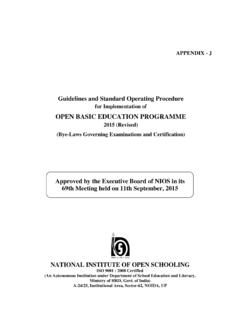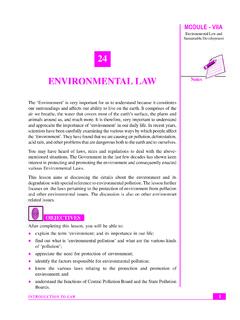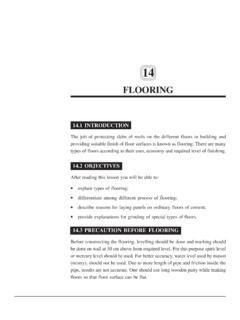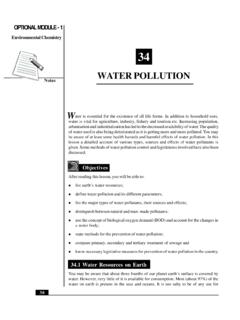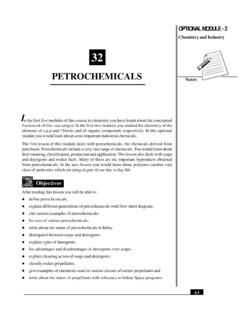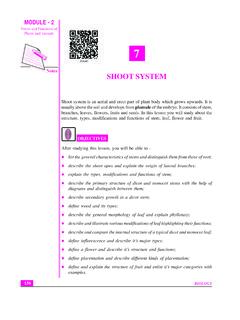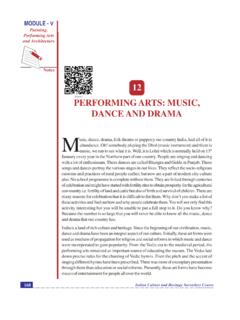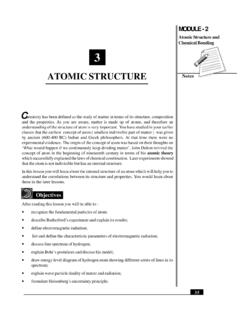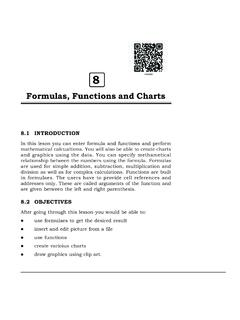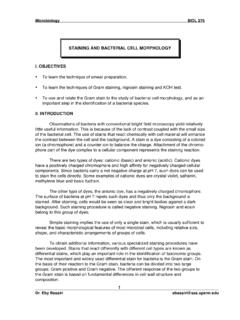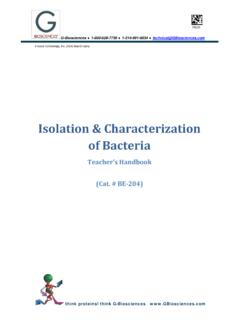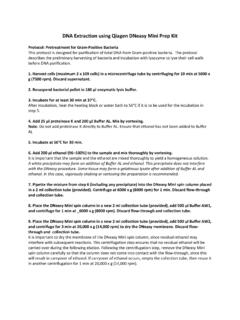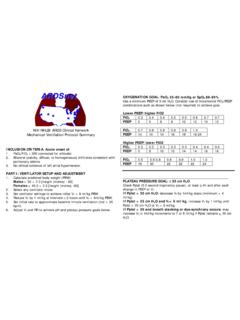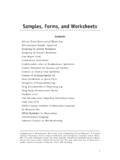Transcription of Notes COMMON STAINING TECHNIQUE
1 MICROBIOLOGYMODULEC ommon STAINING TechniqueMicrobiology 20 Notes2 COMMON INTRODUCTIONS taining is TECHNIQUE used in microscopy to enhance contrast in the microscopicimage. Stains and dyes are frequently used in biological tissues for viewing,often with the aid of different microscopes. Stains may be used to define andexamine bulk tissues (highlighting, for example, muscle fibers or connectivetissue), cell populations (classifying different blood cells, for instance), ororganelles within individual have nearly the same refractive index as water, therefore, when theyare observed under a microscope they are opaque or nearly invisible to the nakedeye. Different types of STAINING methods are used to make the cells and theirinternal structures more visible under the light are of little use unless the specimens for viewing are preparedproperly.
2 Microorganisms must be fixed & stained to increase visibility,accentuate specific morphological features, and preserve them for future useOBJECTIVESA fter reading this lesson, you will be able to:zdescribe the need for STAINING techniqueszexplain terms related to STAINING techniqueszdiscuss the substances used as stainzenlist various STAINING techniqueszclassify & explain various stains 21 COMMON STAINING TERMS RELATED TO STAININGS tainA stain is a substance that adheres to a cell, giving the cell color. The presenceof color gives the cells significant contrast so they are much more stains have different affinities for different organisms, or different partsof organisms. They are used to differentiate different types of organisms or toview specific parts of organismsStainingStaining is an auxiliary TECHNIQUE used in microscopy to enhance contrast in themicroscopic image.
3 Stains and dyes are frequently used in biology and medicineto highlight structures in biological tissues for viewing, often with the aid ofdifferent by itself consists of several steps aims to preserve the shape of the cellsor tissue involved as much as possible. Sometimes heat fixation is used to kill,adhere, and makes them permeable so it will accept stainsWhat can be used as stainThe substance be used as a stain must be colored or it should react in the systemto give a colored product, because of which some portion of the system becomescolored and the rest remains colorless. STAINING renders the organism morevisible, it displays the structure and finer details of bacteria and it helps todifferentiate between organismsStaining techniquesDirect STAINING - The organism is stained and background is left unstainedNegative STAINING - The background is stained and the organism is left unalteredINTEXT QUESTIONS in the blanks:1.
4 STAINING is primarily used to enhance .. in the image2. Substances that adhere to cell giving colour to cell are called as ..3.. aims to preserve the shape of the cells4. The organism is stained and background is left unstained in .. STAINING technique5. Background is stained and the organism is left unchanged in .. STAINING techniqueMICROBIOLOGYMODULEC ommon STAINING TechniqueMicrobiology KINDS OF STAINSS tains are classified aszSimple stainzDifferential stainzStructural or special stainsSimple StainingThe STAINING process involves immersing the sample (before or after fixation andmounting) in dye solution, followed by rinsing and observation. Many dyes,however, require the use of a mordant, a chemical compound that reacts withthe stain to form an insoluble, coloured precipitate.
5 When excess dye solutionis washed away, the mordanted stain remains. Simple STAINING is one step methodusing only one dye. Basic dyes are used in direct stain and acidic dye is usedin negative stain. Simple STAINING techniques is used to study the morphologybetter, to show the nature of the cellular contents of the exudates and also to studythe intracellular location of the bacteriaCommonly used simple stains arezMethylene bluezDilute carbol fuchsinzPolychrome methylene blueLoeffler s Methylene BlueMethod of StainingFlood the smear with methylene blue, allow for 2 minutes, pour off the stain andallow the air to dry by keeping in a slanting position and by this the organismwill retain the methylene blue stainUseMethylene blue STAINING is used to make out clearly the morphology of theorganisms eg. in CSF, Gonococci in urethral pusPolychrome Methylene BluePreparationAllow Loeffler s Methylene blue to ripen slowly.
6 Methylene blue stain is keptin half filled bottles, aerate the content by shaking at intervals, Slow oxidationof methylene blue forms a violet compound and Stain gets polychrome ripening nearly takes 12 months and this is hastened by addition of 1%potassium carbonate 23 COMMON STAINING TechniqueMICROBIOLOGYMODULEM icrobiologyNotesUsePolychrome Methylene Blue is used to demonstrate Mc Fadyean reaction and in this the blue bacilli Is surrounded by purple capsular materialDilute Carbol FuchsinPreparationPrepare carbol fuchsin and dilute it to 1/15 using distilled waterMethod of stainingFlood the smear and let stand for 30 seconds, wash with tap water and blot gentlyto dryUseTo stain throat swab from patients of suspected Vincent s angina, (Borrelia arebetter stained), it is used as a counter stain in gram stain and to demonstrate themorphology of Vibrio cholerae (comma shaped)INTEXT QUESTIONS in the blanks:1.
7 Chemicals that reacts with stain to form precipitates are called as ..2.. dyes is used in direct stain3.. dyes is used in negative stain4. Commonly used simple stains are .., .. & .. DIFFERENTIAL STAINSGram StainingDifferential Stains use two or more stains and allow the cells to be categorizedinto various groups or types. Both the techniques allow the observation of cellmorphology, or shape, but differential STAINING usually provides more informationabout the characteristics of the cell wall (Thickness). gram STAINING (or gram smethod) is an emprical method of differentiating bacterial species into two largegroups ( gram -positive and gram -negative) based on the chemical and physicalproperties of their cell wall. The gram stain is almost always the first step inthe identification of a bacterial organism, While gram STAINING is a valuablediagnostic tool in both clinical and research settings, not all bacteria can bedefinitively classified by this TECHNIQUE , thus forming gram variable and GramMICROBIOLOGYMODULEC ommon STAINING TechniqueMicrobiology 24 Notesindeterminate groups as well.
8 The word gram is always spelled with a capital,referring to Hans Christian gram , the inventor of gram stainingGram STAINING PrinciplesGram STAINING is used to determine gram status to classify bacteria broadly. Itis based on the composition of their cell wall. gram STAINING uses crystal violetto stain cell walls, iodine as a mordant, and a fuchsin or safranin counterstainto mark all bacteria. gram status is important in medicine; the presence orabsence of a cell wall will change the bacterium s susceptibility to someantibiotics. gram -positive bacteria stain dark blue or violet. Their cell wall istypically rich with peptidoglycan and lacks the secondary membrane andlipopolysaccharide layer found in gram -negative bacteriaGram STAINING Technique1. Crystal violet acts as the primary stain. Crystal violet may also be used asa simple stain because it dyes the cell wall of any gram s iodine acts as a mordant (Helps to fix the primary dye to the cellwall).
9 3. Decolorizer is used next to remove the primary stain (crystal violet) fromGram Negative bacteria (those with LPS imbedded in their cell walls).Decolorizer is composed of an organic solvent, such as, acetone or ethanolor a combination of both.)4. Finally, a counter stain (Safranin), is applied to stain those cells (GramNegative) that have lost the primary stain as a result of decolorizationGram ReactionGram-positive bacteria are those that are stained dark blue or violet by Gramstaining. This is in contrast to gram -negative bacteria, which cannot retain thecrystal violet stain, instead taking up the counter stain (safranin or fuchsine) andappearing red or pink. gram -positive organisms are able to retain the crystalviolet stain because of the high amount of peptidoglycan in the cell wall.
10 gram -positive cell walls typically lack the outer membrane found in bacteria are those bacteria that do not retain crystal violet dyein the gram STAINING protocol . In a gram stain test, a counter stain (commonlysafranin) is added after the crystal violet, coloring all gram -negative bacteriawith a red or pink color. The test itself is useful in classifying two distinct typesof bacteria based on the structural differences of their cell walls. On the otherhand, gram -positive bacteria will retain the crystal violet dye when washed ina decolorizing solution. 25 COMMON STAINING TechniqueMICROBIOLOGYMODULEM icrobiologyNotesFig. : gram STAINING TechniqueMicrobiology 26 NotesINTEXT QUESTIONS in the blanks:1. gram STAINING uses .. to stain cell walls, .. as mordant &.. as counter stain2. gram positive bacteria stains.
